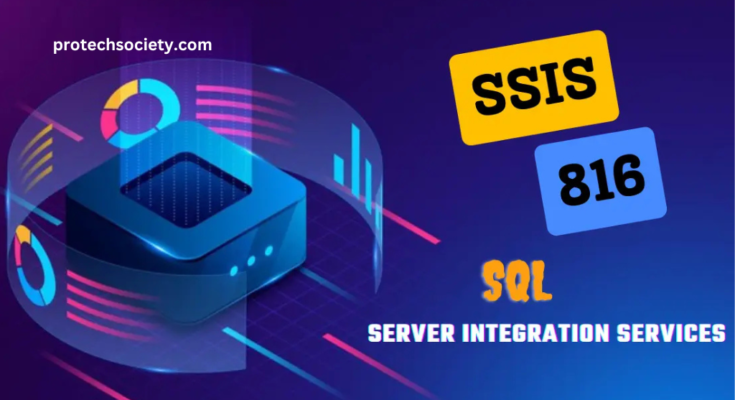SSIS-816, an abbreviation for SQL Server Integration Services-816, is the powerful data integration solution which allows organizations to collect, preprocess, load, and transfer data between different environments seamlessly. It is a focused version of SSIS and has been developed to efficiently handle data flows in complex environments. SSIS-816 caters to the needs of modern businesses that depend on real-time and accurate data.
Seamless integration of data becomes an important factor in this data-centric world. SSIS-816 can simplify the complicated data management process, enabling companies to aggregate data from all possible sources, process it, and transport it efficiently. Given the rising demand for data, SSIS-816 remains a critical component in connecting disparate data sources, further empowering businesses with a more unified view of their data.
Table of Contents
ToggleKey Features of SSIS-816
Efficient Integration of Data Workflow
SSIS-816 integrates efficiency in data integration workflows. It is highly important for large organizations, which have complex and multi-dimensional data flows. This is an opportunity for the users to create automated workflows, thus saving manual effort, consistency, and increased overall productivity.
Scalable Architecture
The most significant advantage of SSIS-816 is scalability. Any company that grows data explosively can use this tool to scale up to that. The architecture of SSIS-816 is developed in such a way that it can handle the smallest and largest data flows without losing performance, so it is suitable for companies of any size.
Efficient Data Management
The framework of SSIS-816 ensures efficient data management with minimal human intervention. It automates a number of processes involved in data integration, such as data transformation and error handling, which translates to time savings and accuracy in data processing.
Automated Workflow Processing
By automating workflow processing, it enables business organizations to process data immediately. Thus, it takes less time for the company, ensuring rapid access as well as data transmission processes, which could be helpful for businesses operating based on recently updated data insights for decision purposes.
Advantages of Developing SSIS-816
Simplifies Complex Data Environments
It is designed to make it easy to manage even the most difficult data environments, with support for diverse data sources and data types. These disparate streams are then gathered together and integrated into a unified workflow, significantly reducing complexity and increasing data usability.
Boosts Data Processing Speeds
Speed in the processing of data is an important factor in today’s fast-paced business world. SSIS-816 stands tall in this aspect as it accelerates the processing speed of data, and therefore is an important tool for those companies that are reliant on high-speed data transfers to support decisions and operations.
Ensures High Data Accuracy and Reliability
Through efficient transformation and validation processes, data accuracy is maintained with the SSIS-816 process. It minimizes errors on data integration, hence assuring that businesses can rely on data for analysis to be accurate and consistent.
Real-Time Data Updates
This makes SSIS-816 more useful for businesses that require real-time data. It provides organizations with the most updated data, which can be helpful in making fast and knowledgeable decisions, such as those required in finance and healthcare.
How SSIS-816 Works in Practice

Data Collection and Preprocessing
It starts with the process of taking data from various sources such as a database, files, and even directly from sites. Pre- processing is done followed by inconsistent removal and then changing of format so that the same data stays ready for any kind of integration process which will be carried out in future.
Data Transformation and Loading
The transformation of data takes place after pre-processing. It performs tasks in data mapping, cleansing, and normalization with the aim of preparing it to be loaded into a central warehouse where all data is readily available for analysis and reporting.
Data Transfer Between Environments
It is also very powerful with the transfer of data. They move the data without hassle in between different environments. For example, it is possible to transfer data from on-premises servers to cloud-based systems, which could be valuable in complex data ecosystems within the business environment.
Challenges and Limitations
Integration with Legacy Systems
It may have integration problems with older systems that do not have the current data integration capabilities. Companies with legacy systems may need to upgrade their infrastructure for full exploitation of SSIS-816.
Training and Implementation Costs
Given the tremendous advantages of SSIS-816, the installation and training could be expensive at first. Organizations should be prepared in terms of setting aside resources for having personnel trained to be able to use the tool to maximum effect.
Conclusion
In a world driven by data, it is an excellent way for organizations to make integration easier and ensure the quality of data. With features of automation, scalability, and efficiency, SSIS-816 is a stand-out business solution for businesses of various types. As the demand for data continues to increase, it becomes an essential tool for every organization that aims to capitalize on the power of integration.
FAQs
What is the purpose of SSIS-816?
It is specifically designed for data integration and workflow applications to control the complexities of data flow.
What is the difference between SSIS and SSIS-816?
Although both belong to the SQL Server Integration Services tools, it is more of a version strictly on data integration and can therefore streamline complex workflows to provide better performance.
Is it possible to perform real-time data integration using SSIS-816?
Yes,it allows for real-time data integration which ensures that businesses are able to make timely decisions based on current information.
Which sector derives the most benefit from SSIS-816?
Sectors such as finance, healthcare, and retail benefit highly from SSIS-816 due to the high demand for real-time and accurate data processing in these sectors.
Is SSIS-816 appropriate for small business?
Yes, it’s scalable to the needs of small, medium, and large-sized enterprises.
Read more about QXEFV



